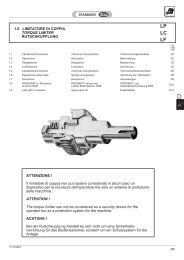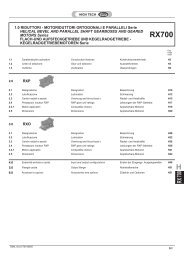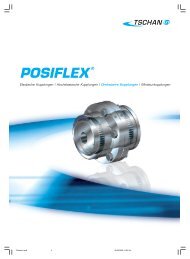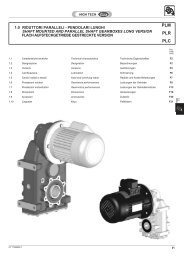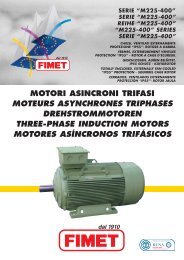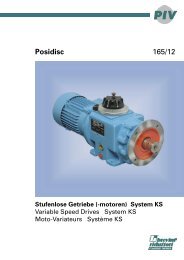You also want an ePaper? Increase the reach of your titles
YUMPU automatically turns print PDFs into web optimized ePapers that Google loves.
1.8 Scelta 1.8 Selection<br />
Noti P’ e n2 scegliere, utilizzando le tabelle<br />
delle prestazioni dei motoriduttori, il<br />
motoriduttore per il quale P1 � P’. Verificare<br />
che il fattore di servizio FS’ del motoriduttore<br />
sia maggiore o uguale di quello<br />
dell’applicazione (FS) altrimenti scegliere<br />
un motoriduttore della grandezza superiore<br />
possibilmente mantenendo invariata la<br />
P1. Segue la verifica di carichi radiali, assiali<br />
e del limite termico (dove previsto).<br />
Per la scelta del riduttore e rinvii angolari<br />
si parte dalla coppia T2‘ richiesta dall’utilizzatore<br />
e dalla velocità richiesta in uscita n2<br />
per un dato valore di n1 (min -1 ). Dalle tabelle<br />
delle prestazioni dei riduttori e/o dei<br />
rinvii angolari, si adotterà quel riduttore o<br />
rinvio angolare per il quale il prodotto T2' x<br />
FS sarà minore o uguale a T2M, dove FS è<br />
il fattore di servizio dell’applicazione. Segue<br />
la verifica di carichi radiali, assiali e<br />
del limite termico (dove previsto).<br />
La scelta del variatore può essere eseguita<br />
tramite le seguenti alternative:<br />
calcolo dell'applicazione, misura diretta<br />
della potenza assorbita su analoga applicazione,<br />
confronto con applicazioni esistenti.<br />
Una volta determinata la coppia necessaria<br />
per l'applicazione occorre consultare<br />
le tabelle di selezione dei variatori nel paragrafo<br />
1.7-G.<br />
Nel caso del variatore di velocità occorre<br />
prestare attenzione alla misura della potenza<br />
assorbita tramite rilevamento elettrico<br />
in quanto questo tipo di misura è<br />
attendibile solo nel caso dei giri massimi.<br />
Nel campo dei giri minimi il rilevamento<br />
elettrico non determina il giusto dimensionamento<br />
in quanto, se l'applicazione è<br />
corretta, l'assorbimento rilevato sarà sempre<br />
molto inferiore a quello di targa del<br />
motore elettrico e pertanto non rilevabile<br />
da termiche o altre sicurezze elettriche.<br />
Le condizioni di funzionamento che rendono<br />
precaria, e comunque sempre da valutare<br />
con molta attenzione, l'applicazione<br />
del variatore sono le seguenti:<br />
— avviamenti: il numero massimo di avviamenti<br />
è funzione del tipo di applicazione,<br />
indicativamente non deve superare i 8<br />
- 10 al 1' e comunque per casi particolari<br />
occorre contattare il ns. servizio tecnico.<br />
— inerzie: nei casi si debbono avviare o<br />
fermare elevate masse senza l'interposizione<br />
di un riduttore, occorre contattare il<br />
ns. servizio tecnico.<br />
Nella scelta del variatore occorre considerare<br />
un opportuno fattore di servizio (FS)<br />
rilevabile nel paragrafo 1.3. Il fattore di<br />
servizio è da applicare sulla coppia nominale<br />
sopportabile dal variatore.<br />
M2 (variatore) � M2 (applicazione) xFS<br />
Attenzione: si ricorda che i prodotti<br />
STM non sono dispositivi di sicurezza.<br />
A12<br />
Once P’ and n2 are known, the gear motor<br />
must be selected referring the performance<br />
tables where P1 � P’. It is also<br />
important to make sure that the service<br />
factor FS’ of the gear motor is equal or<br />
higher than the one of the application (FS)<br />
otherwise a bigger size of the gear motor<br />
has to be selected keeping P1 unchanged.<br />
Then the check of radial, axial loads and<br />
the thermal capacity (where applicable)<br />
follows. In order to select the right gearbox,<br />
the torque T2‘ required by the user<br />
and the output speed n2 for a certain<br />
value of n1 (min -1 ) must be taken into consideration.<br />
Given the above values, select<br />
the corresponding gearbox referring to the<br />
tables of the gearbox performance where<br />
T2‘ x FS is lower or equal to T2M where FS<br />
is the application service factor.<br />
Then check the axial and radial loads and<br />
the thermal capacity (where applicable).<br />
There are many ways of choosing the right<br />
variator for the job:<br />
technical specifications can be calculated<br />
for the applcation in hand; absorbed power<br />
can be directly measured on similar applications;<br />
or simple comparisons can be<br />
made with existing applications.<br />
Once you have determined an application's<br />
torque requirements, simply refer to<br />
the tables on chapter 1.7-G.<br />
Take particular care when using measuring<br />
absorbed power electrically for the purposes<br />
of choosing a variator. Electrical<br />
measurements are only reliable at maximum<br />
speed. At low speeds electrical<br />
measurements do not determine correct<br />
variator size because, if the application is<br />
correctly calculated, absorbed power is<br />
much lower than the rating on the electric<br />
motor's data plate, and is not therefere<br />
likely to have any effect on thermal cutouts<br />
or other electrical protection devices. The<br />
following operating conditions are the most<br />
critical for variator functioning and must<br />
therefore be examined with the greatest<br />
care:<br />
— Starts: The maximum number of starts<br />
depends on the type of applcation. Approximately,<br />
this figure must not exceed 8<br />
- 10 per minute. Contact our Technical<br />
Service if you have any special requirements.<br />
— Inertia: Contact our Technical Service if<br />
high mass machanical parts have to be<br />
standard or stopped without a gear reducer<br />
being installed between the variator<br />
and the part.<br />
When choosing a variator, always allow for<br />
a sufficient service factor (see chapter 1.3.<br />
The service factor must be applied to the<br />
variator's rated torque value.<br />
M2 (variator) � M2 (application) xFS<br />
Attention: STM products are not safety<br />
devices.<br />
1.8 Wahl<br />
Nachdem P’ und n2 nun bekannt sind,<br />
wählt man (mit Hilfe der Leistungstabellen<br />
der Getriebemotoren) den Getriebemotor,<br />
bei dem P1 � P’ ist. Hierbei muß sichergestellt<br />
sein, daß der Betriebsfaktor FS’ des<br />
Getriebemotors höher ist als der Anwendungsfaktor<br />
(FS), da sonst ein größerer<br />
Getriebemotor gewählt werden muß, wobei<br />
P1 nach Möglichkeit gleich bleiben soll.<br />
Anschließend sind die Radial-und Axialbelastungen<br />
sowie die thermische Grenze<br />
(wenn notwendig) zu prüfen.<br />
Bei der Wahl eines Getriebes geht man von<br />
folgenden Werten aus, die vom Anwender<br />
vorgegeben werden: Drehmoment T2‘ und<br />
Abtriebsdrehzahl n2 für einen bestimmten<br />
Wert von n1 (min -1 ). Aus den Getriebe-Leistungstabellen<br />
wird dann das Getriebe<br />
ausgewählt, für das das Produkt T2’<br />
x FS kleiner oder gleich T2M ist, wobei FS<br />
der Betriebsfaktor der Anwendung ist.<br />
Danach sind die Radial-und Axialbelastungen<br />
sowie die thermische Grenze (wenn<br />
notwendig) zu prüfen.<br />
Die Auswahl der jeweils geeigneten<br />
Verstellgetriebe kann nach folgenden<br />
Maßstäben vorgenommen werden:<br />
Berechnung der Anwendung, direkte Messung<br />
der Leistungsaufnahme bei ähnlichem<br />
Einsatz.<br />
Vergleich mit bereits bestehenden<br />
Anwendungen, Nach Ermittlung des einsatzspezifischen<br />
Drehmomentes wird die<br />
Auswahl der Verstellgetriebe mit Hilfe der<br />
Übersichten durchgeführt (Kapital 1.7-G).<br />
Bei Verstellgetrieben ist die elektrische Messung<br />
der Leistungsaufnahme nur bei maximaler<br />
Abtriebsdrehzahl zulässig. Bei niedriger<br />
bis minimaler Drehzahl gestattet die Messung<br />
der Stromaufnahme nicht die Größnauslegung<br />
des Getriebes, weil auch im Falle einer<br />
richtigen Anwendung der eremittelte Wert weit<br />
unter der Leistungsschild des E-Motors liegt,<br />
und weder von Schutzschaltern noch anderen<br />
elektrischen Sicherheiten erfaßt wird. Die für<br />
den Einsatz der Verstellgetriebe kritischen<br />
bzw. mit größter Sorgfalt zu erwägenden Betriebsbedingungen<br />
sind:<br />
— Einschalten: Die maximale Schalthäufigkeit<br />
ist je nach Anwendung verschieden, sollte<br />
aber auf 8 bis 10 innerhalb einer Minute begrenzt<br />
werden. Bei besonderen Anforderungen<br />
bitte mit unserem technischen Büro<br />
Rücksprache nehmen.<br />
— Trägheitsmomente: Unser technisches<br />
Büro gibt gern Auskunft, wenn große Massen<br />
angetrieben bzw. abgebremst werden sollen.<br />
Zur Auswahl der Verstellgetriebe ist außerdem<br />
der geschilderte Betriebsfaktor maßgeblich<br />
(Kapitel 1.3.<br />
Der Betriebsfaktor des Anwendungsfalls ist in<br />
Relation zum folgenden Quotienten zu setzen.<br />
M2 (verstellgetriebe) � M2 (Anwendung) xFS<br />
Achtung: STM-Produkte sind nicht für<br />
sicherheitstechnische Anwendungen<br />
konzipiert.<br />
CT16IGBD2



